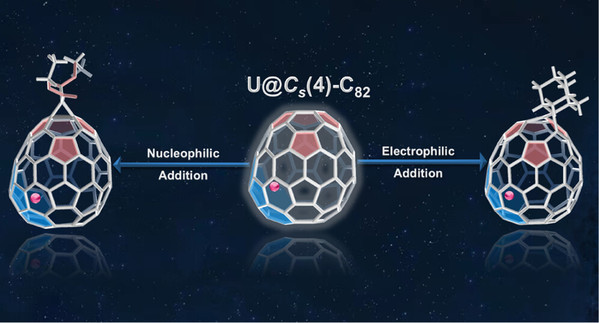U@Cs(4)-C82: A Different Cage Isomer with Reactivity Controlled by U-Sumanene Interaction
Qin Wang1,2, Laura Abella3, Yang-Rong Yao4, Yingjing Yan1,2, Daniel Torrens3, Qingyu Meng1,2, Shangfeng Yang4, Josep M. Poblet3, Antonio Rodríguez-Fortea3*, and Ning Chen1,2*(谌宁)
1College of Chemistry, Chemical Engineering and Materials Science, Soochow University, Suzhou 215123 Jiangsu, P. R. China
2State Key Laboratory of Radiation Medicine and Protection, Soochow University, Suzhou 215123 Jiangsu, P. R. China
3Departament de Química Física i Inorganica, ̀Universitat Rovira i Virgili, 43007 Tarragona, Spain
4Department of Materials Science and Engineering, CAS Key Laboratory of Materials for Energy
Conversion, Anhui Laboratory of Advanced Photon Science and Technology, University of Science and Technology of China, Hefei 230026, P. R. China
Inorg. Chem. 2023, 62, 32, 12976–12988
Abstract:Actinide endohedral metallofullerenes (EMFs) are a fullerene family that possess unique actinide–carbon cage host–guest molecular and electronic structures. In this work, a novel actinide EMF, U@Cs(4)-C82, was successfully synthesized and characterized, and its chemical reactivity was investigated. Crystallographic analysis shows that U@Cs(4)-C82, a new isomer of U@C82, has a Cs(4)-C82 cage, which has never been discovered in the form of empty or endohedral fullerenes. Its unique chemical reactivities were further revealed through the Bingel–Hirsch reaction and carbene addition reaction studies. The Bingel–Hirsch reaction of U@Cs(4)-C82 shows exceptionally high selectivity and product yield, yielding only one major addition adduct. Moreover, the addition sites for both reactions are unexpectedly located on adjacent carbon atoms far away from the actinide metal, despite the nucleophilic (Bingel–Hirsch) and electrophilic (carbene addition) nature of either reactant. Density functional theory (DFT) calculations suggest that this chemical behavior, unprecedented for EMFs, is directed by the unusually strong interaction between U and the sumanene motif of the carbon cage in U@Cs(4)-C82, which makes the energy increase when it is disrupted. This work reveals remarkable chemical properties of actinide EMFs originating from their unique electronic structures and highlights the key role of actinide–cage interactions in the determination of their chemical behaviors.

链接://pubs.acs.org/doi/10.1021/acs.inorgchem.3c01764